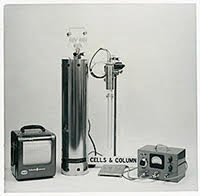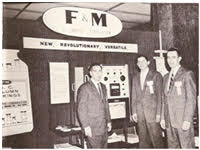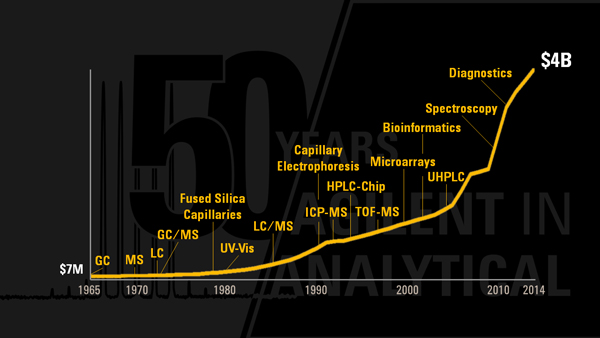In the spring of 1965, the Hewlett-Packard Company announced its fifth acquisition, a company in Avondale, PA, called “F&M Scientific.” At the time, F&M Scientific was one of the world’s leading manufacturers of a new technology called “gas chromatography.”

One of the world’s first gas chromatographs: the F&M 17A
“Chromatography is a relatively new technique for materials analysis,” HP said in its employee newsletter at the time. “Its application has expanded rapidly, particularly in the field of analytical chemistry.”
The acquisition was finalized 50 years ago this month, on August 9, 1965. Gas chromatography enabled HP – and ultimately Agilent – to launch other analytical technology platforms, including liquid chromatography, mass spectrometry and microarray. Leadership in chemical analysis enabled the company to invest in life sciences, genomics and diagnostic.
F&M Scientific began as a part-time basement operation run by an employee of U.S chemical giant DuPont. Frank Martinez, Jr. was a glassblower who worked on analytical and process instruments for in-house use. In 1956, he obtained permission to manufacture gas chromatographs in his spare time. The company took off after a successful advertisement in the magazine Analytic Chemistry, and Martinez resigned from DuPont in 1958 to run F&M (named after his initials) fulltime.
When two other former DuPont scientists – Aaron Martin and C. Eugene Bennett – offered to buy F&M, Martinez proposed a partnership instead. All three founders would later be inducted into the Chemical Heritage Foundation’s “Instrumentation Hall of Fame.”

From left: Aaron Martin, C. Eugene Bennett and Frank Martinez Jr.
F&M wanted to exhibit at the 1959 Pittsburgh Conference on Analytical Chemistry and Applied Spectroscopy (also known as “Pittcon”), but were unable to secure a booth. Instead, they set up in a room on the second floor of the hotel. They displayed an innovative new instrument: the first programmable high-temperature chromatograph, which utilized a thermal-conductivity detector and could operate at temperatures up to 300°C. The instrument became the star of the show, attracting customers including Pfizer, Dow and Esso. For the first time, materials such as petroleum, polymers and drugs could be analyzed in a matter of minutes.
Within a year, F&M extended its temperature range to 500°C. The company grew from three employees to 25, hiring most of the graduating class of Wilmington’s Brown Votech School as manufacturing staff. Sales doubled from $250,000 to $500,000, and continued to double every year. Within three years, F&M Scientific had become the world’s largest producer of gas chromatographic equipment.
And in 1965, with 400 employees and $7 million in annual sales, the company was sold to Hewlett-Packard.
HP continued to operate F&M as a separate business, now called the F&M Scientific Division, and expanded into new markets including environmental, food and drug testing, and crime detection.
“F&M’s gas chromatographs, which can accurately identify and measure minutely small traces of material, are installed in numerous laboratories engaged in pollution control and research,” said a 1967 HP employee newsletter. Applications included analysis of automotive exhaust, air pollution, pesticides, water quality and pollution.
HP also signed a contract with the federal government to develop a specialized line of portable laboratories for testing food products, including grains, forage, dairy and fruits. “Agricultural inspectors will be able to walk right out into the middle of an alfalfa field, take a sample, run it through the portable, self-powered F&M gas chromatograph, and perform all other necessary tests on the spot,” the company proclaimed.
In 1967, German biochemist Manfred Donike demonstrated that an HP gas chromatograph could be used to detect anabolic steroids and other prohibited substances in athletes’ urine samples. As a result, full-scale testing of athletes was conducted for the first time at the 1972 Summer Olympics in Munich, using eight HP gas chromatographs.
HP continued its growth in analytical instrumentation. In 1970 it created the Scientific Instruments Division to develop new technologies for mass spectrometry. In 1973 it entered another adjacent market, liquid chromatography, through the acquisition of Hupe & Busch. One of the company’s most innovative technology breakthroughs was the 1979 invention of fused silica capillary columns, which simplified chemical analysis and enabled more compounds to be analyzed. And the HP 5890, introduced in 1984, remains the best-selling gas chromatograph instrument of all time.
The rebirth of chemical analysis
The spin-off of Agilent in 1999 created the Life Sciences and Chemical Analysis Group. But while the Life Science Solutions Unit was seen as a growth engine and investment area for the company, the Chemical Analysis Solutions Unit was regarded as an older, slow-growth business whose best days were behind it.
Mike McMullen, who led chemical analysis at the time, realized that while the chemical market in the U.S. was slowing, China, other emerging economies and the global food market were getting ready to explode. In fact, emerging economies throughout the world needed to improve the quality of their food, air water an environments. The business shifted the bulk of its investment dollars from the U.S. and Europe into China, India and other emerging economies.
Over the next several years, chemical analysis became one of Agilent’s highest-growth and highest-profit businesses. McMullen’s success in leading the Chemical Analysis helped him to be named as Agilent’s third president and CEO.

A brief history of HP/Agilent’s revenue growth and technology milestones in life sciences, diagnostics and applied chemical markets
Fifty years after the acquisition of F&M Scientific, Agilent’s future looks bright. Leadership in chemical analysis has enabled the company to invest in life sciences, genomics and diagnostics. Last year, Agilent reintroduced itself as a $4 billion company completely focused on those industries.
“We are building a company that will bridge our expertise in analytics to new worlds in the growing life sciences and diagnostics fields,” Mike told employees at a recent anniversary celebration. “We are creating a better world. We are changing individual people’s lives. What could be better than coming to work every day to make that kind of change in the world?
